How to Prepare Kitchen Cabinets for Repainting
How to Refinish Kitchen Cabinets
Bring new life to your old cabinets
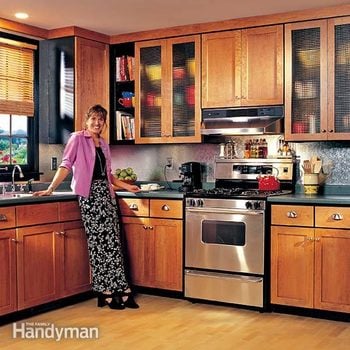 Family Handyman
Family Handyman
Transform dated, worn-out cabinets into attractive new ones. This article shows how to refinish old kitchen cabinets and replace the doors and hardware.
You might also like: TBD
- Time
- Complexity
- Cost
- Multiple Days
- Advanced
- $501-1000
Before your buy new cabinets

Before
It looks hopeless, but with new doors and enameled cabinet boxes you can create a whole new kitchen without the huge expense of replacing everything.
You'll be amazed at how simple it is to update your kitchen without tearing out your old cabinets and completely remodeling. By repainting the cabinets and installing new doors, you can achieve a whole new look at a fraction of the cost of new cabinets. To achieve our dramatic new look, we took off the old doors and painted the cabinet frames with a black, satin-finish oil paint. Then we hung slightly larger cherry panel doors with concealed "Euro-style" hinges. This reduced the space between the doors and eliminated hinge clutter for a more contemporary look.
Our kitchen design combines classic and contemporary elements for a fresh, eclectic look that blends well with many home styles, but these techniques work great to create any style you like. For a more traditional look, consider ordering raised-panel doors, or order flush doors for a sleek, modern look. We'll show you how to apply a smooth and durable painted finish to your cabinets, and then walk you through the process of ordering and installing the right-sized cabinet doors and hinges.
Is this project for you?
This refinish kitchen cabinets project isn't as involved, or as messy, as a complete kitchen remodel, but it's still a major undertaking. Be prepared to devote three or four weekends, a lot of elbow grease and maximum brainpower. There's not much carpentry work involved, but you'll have to plan carefully and measure accurately to get the cabinet doors right. The painting is mainly a matter of perseverance. You'll spend a lot of time cleaning, sanding and spackling before you can even think about putting on paint for the kitchen cabinet refinishing project.
In addition to the painting tools listed below, you'll need basic hand tools plus a drill, a handsaw, a hot-melt glue gun, and a vacuum cleaner with a hose and upholstery brush attachment.
For this refinishing cabinets project we purchased 16 cabinet doors and eight drawer fronts along with new hinges. We found a wide selection of decorative glass at a local stained glass supply store and chose a "crossreeded" pattern. The total cost of the cabinet renewal, not including the bin pulls and knobs, was less than half the cost of standard new cabinets.
(For another approach to renewing old cabinets, see Cabinet Refacing.)
Ordering doors and hinges: How to make a complex job easy
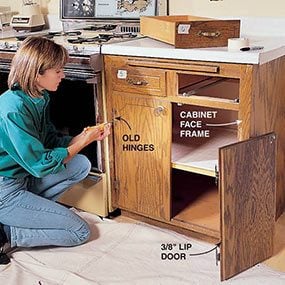
Photo 1: Carefully measure for new doors and drawer fronts
Unscrew the hinges and remove the doors. You'll be reusing the drawers, so number them before taking them out.

Photo 2: Use masking tape to visualize spacing
Apply masking tape to the cabinet face to indicate your desired space between doors and drawers. We used 1/2-in. tape to mimic 1/2-in. spacing. Allow extra space in the corner so drawer knobs don't collide. To find the clearance needed, add the drawer front thickness (3/4 in.) to the depth of the knobs you'll be using and then add at least 3/8 in.
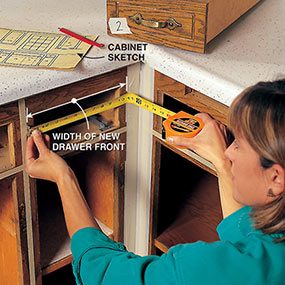
Photo 3: Measure drawer and door sizes
Measure between the strips of tape to determine the width first, then the height, of each drawer front and door. Then record these measurements on a carefully drawn sketch. Measure to the nearest 1/16 in. Number each door and drawer on the sketch. For openings requiring two doors, subtract 1/8 in. for clearance between the doors, then divide the remainder by 2 to determine the width of each door.

Photo 4: Measure for the hinges
Measure from the edge of the frame to the masking tape on the hinge side of every door to determine the distance the door will overlap the cabinet frame. This distance is called the overlay and is needed to order the correct-sized hinge mounting plates. Record this distance next to the corresponding door on your sketch. Subtract 1/8 in. from the overlay to determine the mounting plate size. For example, order 5/8-in. plates if the overlay distance is 3/4 in.
If you're happy with the look of your old cabinets and just want to change the door style, simply measure the old doors and order new ones the same size. Have 35mm holes drilled in the back of the doors if you want to use concealed hinges like the ones we're using.
To achieve the more contemporary look we show here, you'll have to order larger doors to cover more of the cabinet front (face frame). It's not as simple as just ordering larger doors, though. Since the doors will overlap the frame farther than a conventional hinge allows, you'll also have to order a special concealed "cup" hinge that fits into a 35mm hole in the back of the door (Photos 13 and 14). The hinge is attached to the face frame of the cabinet with a separate piece called a mounting plate. Mounting plates are available in different sizes (1/4, 1/2, 5/8, 3/4, 1, 1-1/8, 1-1/4 and 1-3/8, and 1-3/8 to infinity) depending on how far you want the door to overlap the face frame. Photo 4 shows how to measure each door opening for the correct-sized mounting plate.
We used Blum Compact 33 hinges (available at woodworking stores or online), but other brands are available.
The easy way to size and measure for the new doors is to lay out the door and drawer spacing on the old cabinet face frame (Photo 2). Use 1/2-in. masking tape to represent the space between doors and drawers. Measure carefully when you install the tape because you'll use it to determine door and drawer sizes (Photo 3). The masking tape allows you to visualize the spacing and work out details before you order the doors.
Determining the spacing between doors is basically a design decision, but there are a few things to consider. The hinges we used allow the doors to be hung as little as 3/8 in. apart, but spacing doors this close requires accuracy that's hard to achieve on older cabinets. The closer the doors are to each other, the more visible any deviation in the spacing becomes. We chose 1/2-in. spacing because it allowed us a little "cheating" room and still achieved the contemporary look we were after.
This is a great time to make changes to your cabinets, since you'll be painting the frames and can easily fill seams and nail holes. We reduced the size of the wall cabinet doors to the left of the stove and added a narrow open shelf for cookbooks (Photo 8). We also eliminated the cutting boards so we could make the drawer fronts taller, and added 3/4-in. strips to the cabinet above the stove to improve door alignment.
When you're happy with the spacing and have double-checked the inside corners to be sure drawers won't collide after you've added the new pulls, you're ready to measure for and order the doors and drawer fronts (Photo 3). Order doors from a company that specializes in building cabinet doors, or find a local cabinetmaker to build them. Search online for "kitchen cabinet doors." Visit local cabinet showrooms and look at cabinet door literature to choose a door style you like.
Let the cabinet door maker know which brand of 35mm hinge you intend to use and ask him or her to bore the holes for you. This service is well worth the small extra charge. Otherwise you'll have to buy an expensive 35mm bit and use a drill press or jig to bore the holes. Order special doors to accept glass panels.
Door prices will vary, depending on wood type and door style, with cherry and less common hardwoods as much as twice the cost of oak.
Door styles
The old partial-overlay doors left the face frame mostly exposed; full-overlay doors hide most of the frame.
Tips for a smooth, durable paint job
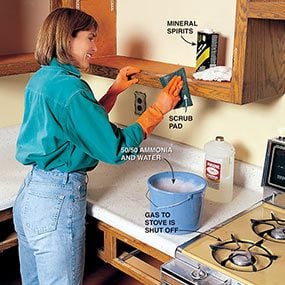
Photo 5: Start the refinishing with a good cleaning
Clean the cabinets with a mineral spirits–dampened rag to remove surface contaminants. Then thoroughly scrub them with a 50/50 solution of household ammonia and water. Finally, rinse with clear water and allow to dry. Sand the cabinets with 80-grit sandpaper to remove bumps and roughen the surface.

Photo 6: Apply filler
Wipe with a bonding solvent. Allow 90 minutes' drying time before troweling a thin layer of spackling compound over the entire surface to fill holes, imperfections and wood grain pores. Deep holes will require a second coat after the first dries.

Photo 7: Sand the cabinets smooth
Sand the spackling compound flush to the cabinet surface with 120-grit sandpaper after it dries. Depending on temperature and humidity, drying time will vary from a few hours to overnight. Wear a dust mask. Look for areas needing additional filling and reapply spackling if necessary. Resand these spots when the spackling dries.
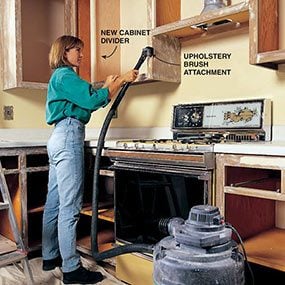
Photo 8: Clean up the dust
Vacuum all of the cabinets and the entire kitchen with an upholstery brush attached to a shop vacuum or powerful home vacuum. Use a strong light to carefully inspect the cabinets for areas needing additional sanding.

Photo 9: Prime the wood
Prime the prepared wood surfaces with pigmented shellac sealer for kitchen cabinet refinishing. Use a good-quality 2-in. brush. Pour about 1-1/2 in. of your primer into a small can and dip the brush about 1 in. Press the brush against the side of the can to remove excess primer. Don't wipe it across the rim; this removes too much primer. Shellac dries very fast, so work quickly and don't go back over areas that have started to dry. Don't worry if the coverage isn't even; just try to avoid heavy buildup and runs. Clean up spills and the brush with denatured alcohol.
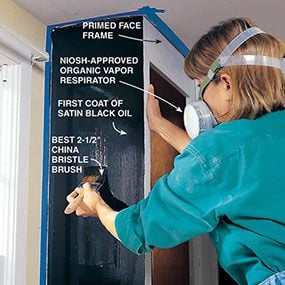
Photo 10: Paint the first coat
Brush on the first coat of paint after lightly sanding the dried shellac with a fine-grit sanding sponge and vacuuming off the dust. Quickly brush on a coat of paint, then smooth it out with long, light strokes using just the tip of the brush.

Photo 11: Sand between coats
Sand lightly between every coat using a fine-grit sanding sponge. Drying time between coats will vary depending on temperature and humidity. Allow at least eight hours. Then vacuum off the dust and recoat. Brush on the final coat. Work from top to bottom so you don't drip on finished areas.
Once the doors are ordered, you can get to the business of painting. Follow the steps in Photos 5 – 11 for a smooth, durable finish. We used oil paint (alkyd) on the cabinets, but top quality (i.e.: the most expensive) acrylic paint or water-based oil finishes do just as well if applied properly.
If you use oil paint and the paint seems thick or sluggish, thin it with up to 6 ozs. of Penetrol paint conditioner per quart until it flows on smoothly. Two or three thin coats of paint result in a stronger, smoother finish than one thick coat.
Whenever you use products with organic solvents, like shellac or alkyd paint, provide plenty of ventilation and wear a NIOSH-approved organic vapor respirator.
The first requirement for a durable paint job is that every coat of paint bond well to the previous layer. Make sure the original cabinet finish is bonded tightly to the wood by making a small "X" with a knife and sticking a piece of Scotch tape over the "X." Now rip the tape off and see if it pulls any finish with it. If it does, you should strip off the original finish before painting. Clean and sand the cabinets as shown in Photo 5 to ensure a good bond to the original finish. We chose shellac as a primer for its ability to cling tenaciously to most finishes. If you use products other than what we're recommending, follow the manufacturer's recommendations and make sure they're compatible with each other.
For a flawless paint job, you must start with a perfectly smooth surface, and maintain a dust-free environment while you're painting. Follow the filling, sanding and vacuuming procedures shown in Photos 6 – 8. Fill large holes and chipped edges with a two-part hardening-type filler like Minwax High-Performance Wood Filler, 12-Ounce Can #21600, available through our affiliation with Amazon.com. It's more durable, hardens quickly and won't shrink like spackling. Sand carefully, using a bright light to check your work.
Paint the insides of cabinets first, then start at the top of the face frame and work down. Lay paint on quickly, then smooth it out with long, light brush strokes. Always work from dry areas into painted areas. Work quickly and complete an area before moving on so you're never brushing over partially dried paint. If paint sneaks onto an area you can't get to soon (around a corner, for example), use a rag dampened with mineral spirits to wipe the paint off. If a run or sag develops, or a hair or speck gets in the paint, let the paint dry and sand it out before recoating.
A Top-Quality Paint Job Requires First-Class Tools
You've got to have the right tools to get a top-quality paint job. Besides, they'll make the job easier and more enjoyable. For one-stop shopping, reliable advice and the best painting tools and products, shop at a reputable paint store rather than a home center or lumberyard. It may cost you a few bucks more, but you'll be buying the tools the pros use. (See Additional Information, below, for a full list of paint supplies.)
- Get a 1-1/2 in. flexible putty knife (not the stiff scraper version) for spreading spackling on the narrow cabinet frames and for filling holes. Then for faster coverage of the end panels and fewer ridges to sand off, pick up a 3-1/2 in. flexible knife.
- A rubber sanding block that holds a one-third sheet of sandpaper is perfect for getting the spackle sanded off smooth and level. Fine-grit sanding sponges are handy for sanding into corners.
- They're not exactly tools, but 1-gal. paint strainers are an essential ingredient for a smooth paint job. They're good for one use and are disposable, so pick up a half-dozen. Pour your paint through the strainer into a separate container before using it. This will eliminate the possibility of lumps from the paint spoiling your perfect paint job.
- Don't use your best brush to prime with shellac. Shellac is a great sealer, but it's miserable to clean out of a brush. Buy a 2-in. medium-priced, good-quality brush for this task and clean it immediately after use with denatured alcohol.
- Like any good tool, a top-quality paint brush is a joy to use, and with proper care and cleaning will last until you wear out the bristles (which takes more painting than you're likely to do in a lifetime). The painters we spoke to buy brushes with a 25 percent boar bristle/75 percent china bristle blend and use them only for the final coats of oil paint. The bristles on these expensive brushes are designed to hold plenty of paint, and are flexible enough and tapered just right to allow you to make those light feathery finishing strokes necessary for a perfectly smooth enameling job. Buy a 1-1/2 in. brush to paint the face frames and a 2-1/2 in. brush for the flat panels. Get in the habit of cleaning your brushes immediately after use with mineral spirits (or warm, soapy water for water-based paints); otherwise, you'll end up with a collection of crusty, hard brushes.
- Buy another 2-1/2 in. china bristle brush to use exclusively with varnish. Otherwise you run the risk of bits of dried paint getting in the varnish.
TIP: Collect the mineral spirits; don't let it run down the drain or on the ground. Store it in a closed container for reuse after the paint solids settle to the bottom. Dispose of the solids at your local hazardous waste facility.
Simple door hanging with stylish concealed hinges
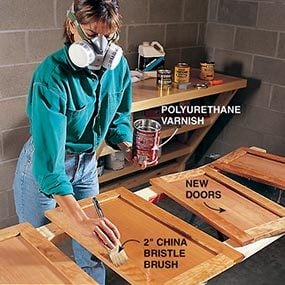
Photo 12: Finish the doors
Stain and seal the cabinet doors and drawer fronts. Use a prestain conditioner on pine, cherry and birch to help even out blotchiness. Use compatible products and allow each coat to dry according to the directions on the label. Sand with a fine-grit sponge between coats of sealer (we used polyurethane) and vacuum off the dust. Use a best-quality china bristle brush for oil varnish or polyurethane. Brush horizontal rails first, then vertical stiles and finally, the flat panel.
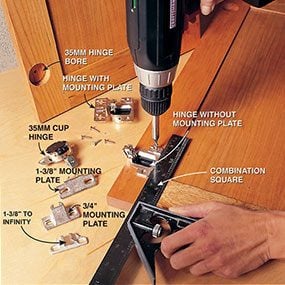
Photo 13: Fasten the hinges to the doors
Press the hinges into the 35mm holes in the back of the cabinet doors. Align the hinge with a combination square and attach it with the small Phillips head screws provided. Refer to your sketch to determine the distance this door will overlay the frame, and attach the corresponding mounting plate to the hinge.
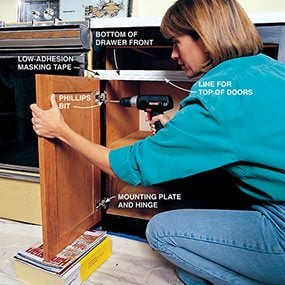
Photo 14: Attach the doors to the frame
Draw lines on masking tape to indicate the edge of the doors and drawers (use low-adhesive tape made specially for sensitive surfaces). Align the edge of the door with the line and put one screw in each hinge. After all doors are hung, adjust them so they align at the top and are evenly spaced. Use a Pozi screwdriver to loosen and tighten the adjustment screw on the hinge. Add the second hinge screw when all doors are hung and properly aligned.

Placing the first screw
Place the first screw in the middle of the elongated hole to allow for slight adjustments.
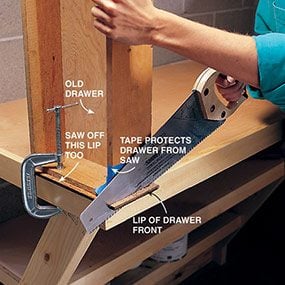
Photo 15: Prepare the old drawers
Saw off the lip on the drawer front that protrudes from the drawer box. Use a handsaw, table saw or miter saw for the ends and a table saw or handsaw for the top and bottom edges. Smooth the edges with a belt sander or wood rasp.
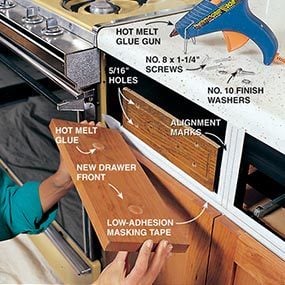
Photo 16: Attach the new drawer fronts
Drill four 5/16-in. holes through the old drawer front. Put two dabs of hot melt glue on the back of the new drawer front. Align the new drawer front with the marks on the masking tape and press it against the drawer for 20 seconds until the glue cools. Carefully pull out the drawer and draw lines on the back of the drawer front to mark its position. Remove the front and scrape off the cooled blobs of glue. Now align the marks and attach the new front to the drawer with No. 6 x 1-1/4 in. wood screws through No. 10 finish washers. The oversized holes allow slight adjustment if necessary.
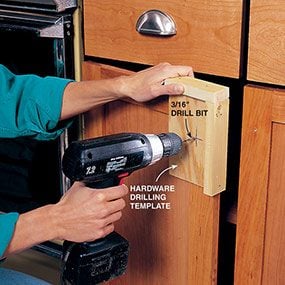
Photo 17: Install new handles
Install drawer pulls and doorknobs. Drill 3/16-in. holes for the knob screws. Use a template to accurately locate doorknobs. Measure carefully for drawer hardware. Use a sharp bit, high speed and medium pressure to avoid splintering the wood on the back of the hole. If splintering is a problem, clamp a small block of wood to the backside of the door before you drill the hole.
By now you'll be pretty good with a paint brush, and just in time, because the new doors will need to be sealed (Photo 12). You may be able to avoid this task by ordering prefinished doors. We finished our doors with one coat of prestain conditioner, one coat of oil stain, and two coats of polyurethane varnish. The prestain conditioner helps prevent uneven stain penetration on blotchy woods like cherry, pine and birch. Lightly sand and vacuum between varnish coats for maximum smoothness.
Photos 13 and 14 show how to install the hinges and hang the doors. This is the moment of truth when you'll find out if the doors you ordered really fit as planned. Single doors usually don't present a problem, but pairs that join in the center are tricky. Don't panic if they're too tight or have too large a gap between them. If the hinges don't adjust far enough to correct the problem, change the mounting plates. For example, if the doors are too tight with 3/4-in. overlay plates, change the plates on one door to 1-in. overlay.
Tip: Order a few extra pairs of mounting plates with the next larger and smaller overlay to allow maximum flexibility when you're hanging the doors.
In a pinch, you can also increase the space by chiseling a notch in the edge of the face frame for the mounting plate to drop into, or put a small shim under a mounting plate to reduce the space.
Adjust the doors up and down by moving the mounting plate, and sideways by loosening the adjusting screw on the hinge. The adjusting screws look like Phillips head screws but are actually designed to be used with a special Pozi screwdriver. Pozi screwdrivers are available where hinges are sold. Install and adjust the doors before installing the drawer fronts. When all the doors and drawers fronts are on and adjusted, go back and add the second screw to the hinge mounting plate and tighten all the adjusting screws.
Now all that's left to do is install the drawer pulls and door handles (Photo 17). Once things start looking this good, it's hard to resist making a few more changes. We filled the large space above the upper cabinet doors with cherry boards, and added galvanized sheet metal to the backsplash area. The new countertops are prefabricated plastic laminate (available through lumberyards, home centers or online).
Attaching Drawer Fronts
Figures C and D show how to fasten the new drawer fronts to either a flat panel or raised panel drawer.
Additional Information
- Paint Supplies Shopping List
Required Tools for this refinish kitchen cabinets Project
Have the necessary tools for this refinish kitchen cabinets DIY project lined up before you start—you'll save time and frustration.
You'll also need rubber gloves, an organic vapor respirator, a 3 1/2-in. flexible putty knife and a Pozi screwdriver.
Required Materials for this refinish kitchen cabinets Project
Avoid last-minute shopping trips by having all your materials ready ahead of time. Here's a list.
For a complete list of painting supplies, see Additional Information.
Similar Projects
How to Prepare Kitchen Cabinets for Repainting
Source: https://www.familyhandyman.com/project/how-to-refinish-kitchen-cabinets/
0 Response to "How to Prepare Kitchen Cabinets for Repainting"
Post a Comment